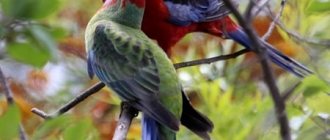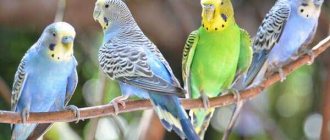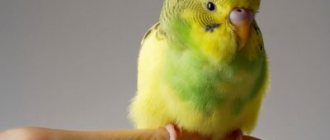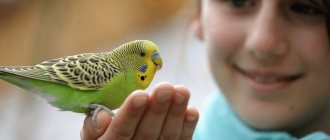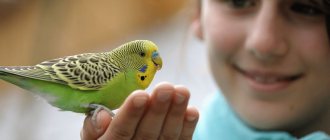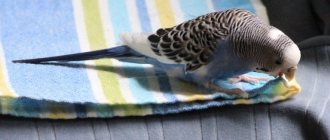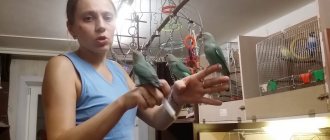To uninitiated people, the singing of budgies may seem like meaningless bird chatter. After all, parrots are not the usual dogs or cats, whose habits have long been studied and understood. However, they are the same living beings, having their own preferences, individual character and even personal opinion. With the help of bird trills and a special behavior characteristic of a particular case, a parrot can tell its owner about its needs, the joy of meeting a person, or, conversely, express dissatisfaction.
After reading the article, you will learn how to decipher bird language and learn to better understand your pet. You will also be able to see with your own eyes all the variety of dances and hear what sounds parrots are capable of making while living side by side with humans.
Singing budgerigars
All the names of budgies are in one way or another connected with the words “noisy”, “singing”. This is explained by their special love to chat, sing, make noise, which is what they do all day long. The approach of the flock can be heard from afar, even before it appears on the horizon.
Interesting! Parrots produce a whole range of sounds from screams and chirps to melodious trills, but most owners do not understand what the bird wants to say with its singing. In fact, everything is extremely simple - you need to watch the parrot, listen with what speed, volume, intonation it sings this or that song or pronounces individual sounds.
In their natural environment, parrots live in pairs. Singing for them is a kind of roll call so that the partner does not get lost in the pack. With the help of chirping, they call their offspring in different tones, pronouncing “chivik.” Each bird has a personal designation akin to a person’s name, so the chicks understand perfectly well that their parents are addressing them and fly to the call.
In the morning, the birds hold something like a meeting about where the flock will go today. Budgerigars scream loudly, scream in every possible way, the noise is several times greater than the warm-up of an instrumental brass band. Then the flock soars up in an instant, the tonality of the budgies' chirping changes to a calm, everyday melody.
When the mating season begins, parrots coo in a particularly quiet, gentle way. Similar behavior is observed both in already formed couples and in single male budgerigars, who try to attract the attention of the females they like with romantic songs. The male sings the same songs to the female who is incubating the eggs.
Should your pet listen to the singing of other birds?
Budgerigar owners are arguing over recordings of their parrots singing. Some argue that the bird moves closer to the source of the sound and begins to sing along. So the wavy does not get bored when he stays at home all day long.
Other birds become despondent at the sound of parrots singing. They may become hysterical or sit sullenly and begin to pull out feathers. Each parrot has its own individual character. If he needs a girlfriend, then he is unlikely to have fun.
Parrots fly from place to place in large noisy flocks
For birds, singing is also a way not to lose each other among hundreds of relatives. Unlike other bird species, parrots are considered to be in pairs. For example, a flock of 20 or 100 pairs. The simple “chivik” is pronounced by birds in various variations and is akin to a human name.
The budgerigar sings its “chivik” in different modes, calling the children together. The chicks already leave the nest at 2 months. Parents feed them for up to six months. Every day they shout their names, calling similar young animals from the flock. These are those rare cases when the female also sings loudly, helping the male. During the flight, the pairs constantly call each other. As the wavy moves through the air, it makes random movements, constantly changing direction and height. If you look from a distance, the flock constantly changes its shape and at the same time moves in one direction.
How parrots sing in the morning when they wake up. Just as sharp and loud as at home. Only along with warming up their voices do they hold a kind of meeting about where they will fly today in search of food. The cacophony surpasses all the brass band's pre-rehearsal warm-ups. Then the flock, as if on command, rises into the sky, and the singing tone changes to normal. It's as if a conductor chosen by the community gives a command.
How a budgerigar sings for his only parrot. The most beautiful trills sound during the mating season. Bachelors diligently sing their songs, attracting the attention of young females. Family birds declare their love to their friends with gentle coos. They answer them with similar singing. Such sounds are pronounced quietly, like the murmur of water, and while the female is sitting on the eggs and the male is feeding.
In the evening, the whole flock, tired and contented, sits on the branches of a tree and, like a domestic bird, expresses its condition by cooing “kwe”. Then everything suddenly calms down, the sun has set and everyone is sleeping. Only a rare “quaw” can be heard when someone disturbs the bird.
Why do birds dance and sing?
Parrots are known as avid music lovers. Moreover, individuals living together may have completely different musical preferences. What kind of music a particular budgie will like and become a favorite will depend on its temperament and character. So, some prefer the sounds of an instrumental orchestra, while other budgies like songs that have vocal accompaniment. The bird sings along with the performer, imitating intonation, repeating individual words, thereby expanding its vocabulary.
Interesting! Most budgies do not like listening to club music or techno music. The bird becomes aggressive and can scream and flap its wings.
Many owners report that their pets, in addition to singing, love to dance, and this activity completely captivates them for several hours. Parrots really have a sense of rhythm, they move well to the beat of the music: they rhythmically wave their heads and wings, dancing and moving their paws.
It is difficult to reliably explain the fact that parrots are addicted to music, singing and dancing. Scientists have helped bring some clarity by finding nuclei in their brains responsible for learning, which no other bird has. These are isolated groups of neurons that help parrots remember and later reproduce sounds. They are closely adjacent to the motor centers of the brain, which allows the speech center to control the movement of the tongue, and at the same time the rest of the bird’s body. Regarding what kind of music budgerigars like, a close relationship has been discovered between the preferences of the pet and its owner.
What can I do to make my parrot start chirping?
So, the parrot was chosen, purchased and placed in its new cage. What should you do next, given that you want to fill your home with cheerful songs as soon as possible? First of all, you should not rush things and try to force the parrot to start tweeting here and now. This applies especially to the first days of a bird’s life in a new place.
Give him some time to feel like a full-fledged member of the family, that is, of the pack, and also understand that there is no danger in the objects around him. You should also not actively make contact at these moments, try to shout at the bird, pick it up, jump and run around the cage (applies to children), and generally do not make any sudden and unexpected movements.
You begin to slowly communicate with him, using calm intonations; if the bird makes contact on its own, then play along with him, but not too actively. If he suddenly sits on your shoulder, then let him stay there as long as he wants and do not try to hold him. If you do everything correctly, then after a fairly short period of time, the parrot will gain confidence in you and, most likely, will want to please you with a song or just a funny chirp.
If you feel that you are doing everything right and behaving naturally, but the parrot is still silent, then there is one little trick that works nine times out of ten. Let's say that the bird has been living with you for two weeks, feels quite at ease, but is still silent, like a partisan. In this case, you will need to download recordings of parrots chirping from the Internet and play them loud enough for your pet to hear them.
Believe me, the call of relatives, even if virtual, will most likely get your parrot talking. In addition, recordings of roaring water or simply calm melodic music may be suitable for these purposes. Experiment, everything here is purely individual and each particular parrot may “like” its own sounds. The main thing is that they are calm, beautiful and not repeated too often.
Sounds of budgies
Various sounds in the repertoire of budgies change their meaning when intonation changes. But an attentive owner will easily understand what his pet wants to say with his singing, and a kind of short bird language translator presented below will help him with this.
- If there are any changes in the appearance of the owner or in the room where the bird is located, and the parrot notices them, he will express surprise by repeating the cry “piu”.
- The feathered one, dissatisfied with the innovations, repeats “quaw” sharply and loudly for a long time.
- The incessant cheerful singing of the chivi-chivi bird indicates that it is interested in something unfamiliar to it or is doing something that is forbidden. For example, he damages furniture, wallpaper, or tries to chew through a wire.
- The sounds of “cha-cha” pronounced in a loud, harsh voice mean that the bird is scared. They, said with a calmer intonation, speak of the parrot’s high spirits. If the sound becomes more intense and louder, then the bird wants to be let out of the cage for a walk.
- The bird uses the “pichi” call when it seeks communication with other birds it sees outside the window or sitting nearby in a cage. Calm singing is most likely addressed to a person or other pet.
- A gusty, loud “pitii-pitii” whistle heard from a budgerigar can mean dissatisfaction. At this moment, the parrot quickly walks around the cage, spreading its wings. Translated from his language, this indicates that the bird was disturbed or, conversely, little attention was paid.
- The chirping of “chak-chwa” parrots is nothing more than a joyful greeting to a person or pet.
- If a budgie constantly interrupts its songs with a sharp “pity”, this means that something is bothering or irritating the bird, and it needs to be removed from the cage. It can also mean that the parrot is hungry. He will shout out his demand until the owner stops what he is doing and pays attention to the bird.
- A budgie that is forcibly held in the hands or frightened screams “kweee” heart-rendingly.
- In the evening, sitting in the cage, the parrot will switch to a peaceful, increasingly quiet “kwe”, which, translated from bird language, means that it is time to go to bed.
How do these birds sing?
It is not completely known why males perform more often than females. The female, of course, also sings, but less often. If you hear the cheerful loud performance of a male, whether he is alone or in company, it means that he is healthy and also full of joy and energy. In video and audio recordings you can fully immerse yourself in this symphony.
If you haven’t yet figured out why your lonely parrot trills in front of some objects, then know that it’s time to look for a mate. If the male is not alone in the cage, then with such glorious singing he can flirt and attract the attention of females. There is a more gentle, quiet version, which can often be heard when a partner feeds his girlfriend. She, too, can respond with the same gentle, quiet singing when she is satisfied with his advances.
Summarizing
A budgie, like any other pet, requires sufficient time and attention from its owner. If the owner is patient and regularly works with his pupil, then soon the training will bear fruit - the bird will speak, repeating not only individual words, but also entire sentences. He will copy intonation, surrounding sounds, and delight family members with dancing and cheerful singing.
An attentive owner who has studied the habits of a feathered pet will be able to find a common language with it. This will make it comfortable for both the bird, whose needs will be understood and satisfied, and the owner, who can quickly determine by the behavior and singing of the budgerigar his emotional state, the cause of anxiety or joy.
Who is the best singer
Male budgerigars sing best. They can sing both for themselves and for their relatives for a very long time - more than one hour in a row. From a very early age, from three to four months, males begin to make various sounds and cries. Young parrots learn from older, more experienced males. If a bird lives alone in a cage, then it has every chance of quickly learning human speech.
The domesticated parrot sings mainly for its own pleasure. But in the presence of a female, he is very active: his especially loud cry is accompanied by certain dances.
Female budgerigars behave modestly. Their sounds are calmer. The birds' song is short and not as multifaceted as that of males. Why females are more difficult to teach words.
Experiments
English zoologists decided to conduct an experiment to understand what kind of music parrots prefer. For this purpose, representatives of the smartest breed - Grays - were involved. The three birds were played music in different styles. It turned out that birds like rhythmic music the most. Classical melodies had a calming effect.
During the study, a special screen was placed in front of the parrots, on which there were two buttons. Using the first button, the birds could turn on rhythmic music, and when they pressed the second, a quiet and calm melody began to play. The parrots sang and danced to different songs with pleasure, so it was not possible to find out exactly which type of music they liked the most.
Ornithologists from Indiana conducted their own experiment with the parrot Snowball. Scientists have made several videos that have attracted the interest of psychologists and neurophysiologists. The bird was played different songs, while listening to which the bird made approximately 14 simple movements, as well as 2 complex ones. For each composition, he chose the most suitable actions to the rhythm. He used different movements for each song.
Captivity
Keeping song parrots in captivity is not much different from keeping other species of parrots. These birds were domesticated in the mid-19th century, and have since become well adapted to life in artificial conditions. Representatives of this species get bored alone, so they should be kept in pairs. Group keeping is undesirable, as conflicts over territory will constantly arise between birds. Males become especially aggressive during the breeding season.
Cage and accessories
Song parrots are active birds, so they should not be kept in cramped and small cages. Their home should have enough free space for active movement and flight. The minimum dimensions of the cage are 80x40x60 cm, but it is better to house the birds in an aviary 2-3 m long and at least 80 cm wide. The following should be placed inside:
- feeders for dry and wet food;
- drinking bowl;
- 2-3 perches;
- bathing suit;
- toys - ladders, ropes, swings;
- branches of fruit trees for grinding claws and beak - 2-3 pieces per bird.
The bottom of the enclosure or cage is covered with sawdust or sand (layer thickness - 3-5 cm). The parrots' home is regularly cleaned: the feeders, bathing bowl and drinking bowl are washed daily, the bottom is also cleaned every day, and the perches and toys are cleaned once a week. The cage is washed and disinfected once a week, and the enclosure once a month. General cleaning is carried out every six months.
Diet
Song parrots are not picky and eat the same food as other parrot species of similar size. Their diet should consist of 70% grains and seeds: corn, millet, oats, wheat, canary grass, safflower, sunflower, sesame. In addition, the diet includes legumes, greens, vegetables, fruits, berries, nuts, low-fat cottage cheese, boiled eggs, and insects. For birds, crumbly porridge is cooked in water without salt or sugar. Vitamins are added to the food. Mineral supplements should be freely available - chalk, sepia, crushed eggshells, bone meal, sand.
Important! Parrots are fed twice a day - morning and evening. For drinking, use distilled or filtered water.
Parrots should not be fed garlic, onions, fresh bread and pastries, spices, tomatoes, eggplants, sorrel, persimmons, avocado, pineapple, milk, sweet, fried, salty and smoked foods.
Comfortable conditions
Song parrots do not tolerate low temperatures well. The air temperature in the room where these birds are kept should be maintained at 25-30°C. Sudden temperature changes should not be allowed. Air humidity should be 60-70%. The room should be bright, clean and well ventilated.
A cage or aviary with parrots should not be placed in a draft or near heating appliances. Prolonged exposure to direct sunlight should be avoided. To maintain humidity, you can spray your parrots with water from a spray bottle.
Breeding
Breeding song parrots at home is not very difficult. Birds reach sexual maturity at 14-16 months. With good care, they are ready to bear offspring up to 3 times a year.
In nature, the mating season of song parrots lasts from September to May. In captivity, the nesting period is usually between September and November. Producers are prepared for breeding in advance: they increase the proportion of protein feed and mineral supplements in the diet, and also increase the length of daylight hours. In the aviary or cage where the parrots live, place a nesting house made of plywood measuring 25x25x35 cm with a entrance with a diameter of 6 cm. The bottom of the house is covered with sawdust or sand (layer thickness - about 2 cm).
If the producers are ready to breed, the male begins to court the female. He sings and dances: he shakes his wings, squats, moves his head. After completing the dance, the male spreads his tail like a fan and feeds the female. Parrots often sit for a long time, huddled together; the female can sort out the feathers on the male’s head.
After mating, the female lays 4-8 eggs and incubates them for 21-26 days. At this time, the male feeds and protects his partner. Both parents take care of the hatched chicks. At this time, their diet should consist mainly of animal feed. The chicks begin to leave the nest at the age of 1 month. Parents feed them for another 15-20 days. At the age of 8 weeks, the chicks become completely independent. At this time they are separated from their parents. If the chicks are not removed, the adults will begin to show aggression towards them, trying to drive them away from their territory.
After the chicks are laid, the female begins to prepare for a new clutch. To give the birds the opportunity to rest and molt, the nesting house is removed from the enclosure.
On a note! During the process of domestication, various color variations of the red-backed song parrot were developed: lutino, cinnamon, opaline, orange, blue.
Wild Lifestyle
Song parrots are Australian birds that inhabit the Southeast of the mainland. They are considered the most common parrot species in Australia. They can be found both in savannas and meadows, both in parks and pastures, both in mountainous areas and in orchards. Birds do not like densely forested areas and are attracted to open areas with few trees and shrubs. They are also not afraid to settle near human buildings and often make nests in barns and attics.
Usually these birds gather in large flocks and only during the nesting period do they separate in pairs and firmly defend their territory.
What song parrots eat in nature:
- wild herbs;
- seeds;
- kidneys;
- berries;
- fruits from bushes and trees;
- small insects
- and even grains of sand and small pebbles.
They are not afraid to pick up grains on farms that have not been eaten by livestock and poultry. Sometimes they can cause damage to grain crops, but the damage is so insignificant that they are not considered pests.
Other possible reasons
Frequently repeated screams for no particular reason may be a reason to contact a veterinarian. It is important to pay attention to the bird's call in the following cases:
- When you hear a sharp sound made by a bird, you need to check whether the feeder and drinker have everything you need. Some parrots scream if they are unhappy with the lack of food or water.
- A parrot, living under the same roof with a person for a long time, begins to be jealous of its owner towards other pets. Stroking a cat or playing with a dog in the presence of a bird can make the latter jealous, and he will start screaming loudly.
- Prolonged loneliness also causes a storm of indignation in the bird, and it begins to scream from boredom. You cannot leave a bird alone in a closed room for a long time; this has a detrimental effect on its psyche.
Do birds like melodies and songs?
Birds in the wild use different sounds to search for a partner, notify the flock of predators, or communicate with each other.
They use not only individual sounds, but also full-fledged songs. Therefore, different melodies evoke positive emotions in them.
If you play different songs for the wavy, you can see how they begin to sing, dance or even kiss with their mirror image or couple.
On the Internet you can find special selections for free that almost all birds like. They include a pleasant melody, chirping, soft voice, chirping and singing.
How to help
- If the bird is sick, timely medical attention is essential. In small birds, all processes proceed quickly. Knowing the main symptoms, you cannot postpone a visit to the doctor until later.
- During the adaptation period, do not disturb or frighten the bird. Talk in a calm voice, slowly accustoming her to you.
- To smooth out the seasonal blues and improve the quality of life of an adult bird, regular vitamin intake and protection from stress are recommended.
- In cases of boredom from loneliness, one of the options is possible: get a friend, but only of the opposite sex, or give the pet more of your own attention.
Description, appearance
Nature has awarded the genus of song parrots with a very bright color:
- green feathers stand out on the back, head, chest, wings and coverts, and yellow feathers on the belly;
- in the area of the sacrum (uppertail) there are brick-red feathers;
- there are yellow spots on the wings, and the wings themselves are bordered with bright blue;
- the beak is gray, closer to black;
- flesh-colored paws;
- body length reaches 28 cm, tail plumage is long, stepped - up to 14 cm;
- The iris of the eyes is dark brown.
The photo of song parrots shows how obvious the difference is between males and females: the latter have dull, olive-green, or even grayish plumage, and they do not have a red spot on the rump.
Female and male song parrots
For birds, it is important that females have dull plumage and are less noticeable than males - it is the females that play the main role in maintaining the population of the species.
Many owners wonder: do song parrots talk? Unfortunately no. These birds can sing, perform roulades during the day, and whistle, but they cannot repeat human speech.
Other types of song parrots:
Multicolor (variegated)
Hooded
Golden-shouldered (yellow-winged) or Queensland
What to feed a song parrot
These birds are very picky, so you won’t have to constantly worry about what to feed your song parrot. The standard diet that is used to feed small parrots suits them well.
Their menu may include oats, buckwheat, millet, canary seed, sunflower seeds, sprouted millet, boiled corn, fruits, fresh herbs, and berries.
If the female feeds the chicks, then it is necessary to enrich the diet with food of animal origin - eggs, cottage cheese, and also give more greens and sprouted grains.
Song parrots will not refuse carrots, apples, pears, bananas and pomegranates. You can give flowering branches of some trees or shrubs.
It is interesting that these parrots take such meadow plants as dandelion leaves and dry plantain seeds as a delicacy.
The first days of a parrot in the house
The first days of its stay in a new environment are very important for a budgie. Before you bring the bird into the house, you should purchase a cage, feeders, drinkers, and food for it in advance. Choose a place where the cage will stand - it is not advisable to move it when the parrot is already inside. Being in a new environment will certainly be stressful for your pet. Try to contribute as much as possible to his speedy adaptation. During the first days, you should approach the bird as little as possible, giving it time to calm down and look around. It is recommended to cover the top of the cage and its side walls with a light cloth. This way the bird’s horizons will be smaller, which means it won’t worry so much, feeling like it’s in a kind of “house.” In a few days, when the parrot begins to chirp in the morning and finally explores the cage in which it is located, you can begin to get acquainted directly. Sit opposite the cage so that your face is on the same level with it, and speak to your pet in a gentle, calm voice. Call him by name several times - budgies are quite smart, and very soon your parrot will begin to associate this new word with himself. By talking to your bird regularly, you will begin to notice how he tilts his head, listening to you, and, overcoming fear, comes closer to you along the perch. This means your new pet is ready to be tamed.
What kind of bird is this - a talking parrot?
In nature, there are several dozen breeds, species and subspecies of parrots. The most numerous species are budgerigars. They are also called singing or talking parrots. If they live in the wild, they gather in multi-colored flocks of millions. At birth, the main color of a parrot is yellow. As they mature, blue or green colors appear. Now, through selection, parrots of all colors and colors are bred. The plumage can also be different. For example, the “chrysanthemum,” an experimentally bred breed of parrot, has a feather length of about 10 centimeters.
Where did such a miracle bird come to us from?
The homeland of parrots is Australia. The budgerigar is one of the most numerous and widespread species of parrots.
The first descriptions of a talking budgerigar can be found in the scientific works of the Englishman D. Shaw. In 1805, the Artist G. Nodder first captured this bird on paper. It was the idea of exiled convicts who were deported to Australia to put parrots in a cage and begin to tame them.
In 1840, budgerigars were introduced to Europe. A few years later, data began to appear on attempts to breed birds in laboratory and home conditions. But the birds were exotic and expensive, so only rich people could afford to keep them.
What compositions are chosen?
When choosing music for a wavy, rhythm and dynamics are taken into account. Birds are not experts, so they may like a completely unusual song. Even whistling evokes pleasant emotions in some individuals. Some birds prefer to listen to classical music, while others like dance tunes.
Statistics show that birds have a positive attitude towards music with words, so ordinary electronic tracks are sometimes ignored. If you turn on monotonous music at all, the bird may become depressed or begin to behave aggressively.
This behavior is due to the fact that the brain of parrots is more complex than that of other birds. They can perform complex cognitive tasks, so they can concentrate, perform dance moves, and are also distinguished by developed thinking.
Does your parrot like to listen to music?
YesNo
Usually birds do not concentrate on only one musical style, therefore they are considered music lovers:
- they have a positive attitude towards dance music, so they dance and chirp in unusual ways;
- parrots respond well to hip-hop, and some individuals are also fans of chanson;
- aggressive music, such as synth-pop, can cause stress in the bird;
- It is not recommended to play rock music loudly in the room where the bird lives, since even some people cannot quietly listen to such music;
- Electronic or club music without words can cause aggression.
Therefore, it is recommended to choose music wisely so as not to spoil your pet’s mood.
Imitation
Each wavy has its own unique characteristics, so birds react to the same music in a special way. Bird observations show that it is usually house wavy birds that respond to music by dancing and chirping. This is due to the fact that they live with people for a long time, so they imitate human behavior.
People begin to move, wave their arms and crouch during rhythmic and dance music. Parrots observe this behavior, so over time they begin to imitate humans. Copying the movements of the owner, they begin their own unique dance. After all, it is the wavy birds that are represented by amazing birds that copy human speech and behavior.
But not only imitation is the main reason for dancing, since music is an integral part of their life. Their entire existence is filled with sounds, chirping and singing. Birds enjoy pleasant melodies. On the Internet you can find many videos where wavy birds dance beautifully and rejoice in songs.
